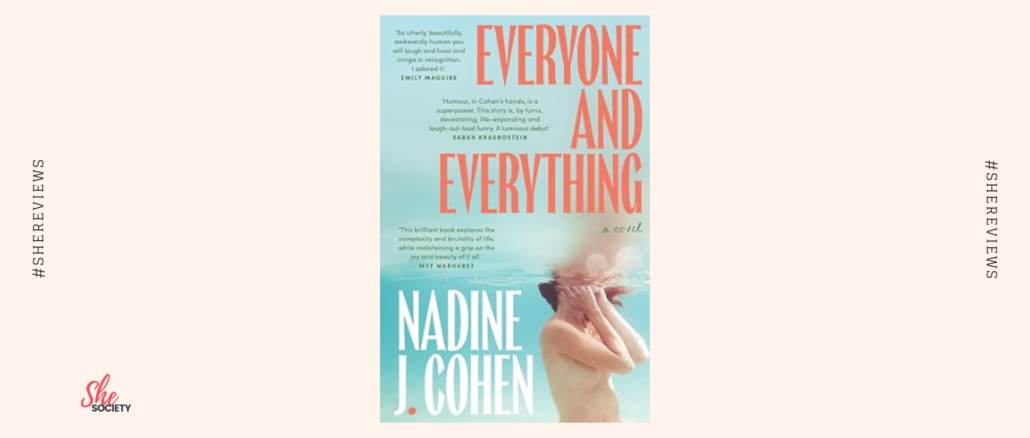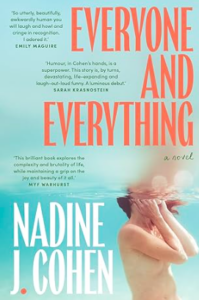
Mental health is for some a dangerously slippery slope. Where an avalanche of psychological ‘nasties’ invade one’s life when they are least wanted (‘nasties’ including severe depression, anxiety and panic attacks and general but engulfing sadness). Often the mentally ill have little reprieve or rest, and living life is an exhausting and intimidating mountain to climb.
Such poignant, yet realistic, truths are heartbreakingly (yet also kindly and compassionately) examined in stellar Australian writer and refugee advocate, Nadine J. Cohen’s, exemplary debut novel, Everyone and Everything.
Set in the frenetic, yet also serene in places, metropolis of Sydney’s Eastern Suburbs during the course of one year, this lovingly written novel turned out to be a gem that I hadn’t known (prior to reading) that I’d needed.
Yael Silver (our protagonist) is a thirty-four year old writer (of television, advertising and so on) living in her non-descript flat, with only her standoffish cat, Julia Louis-Dreyfus, for company.
Life, for Yael, is most definitely not going according to plan. She feels she has “failed” at life. Devastatingly, Yael has recently had a complete and brutal nervous breakdown (this has manifested as a ‘major depressive disorder’, severe anxiety and anxiety attacks.) And she has three options (which are given to her by her psychiatrist of five years, Dr Priya Hoffman), and none of them are wonderful for Yael. Her choices are that she can go to rehab, she can go to live with her older sister, Liora, or simply stay put in her flat.
It’s decided that Yael will stay at her flat. The prerequisites for this to occur are that “1. Liora comes over tonight and takes away all pills. 2. (Yael) check(s) in with Priya every day, twice a week in person. 3. (Yael) spend(s) minimal time at home alone.”
Priya is ‘out there’ in the way she dresses and as psychiatrist (Yael and Priya have spent two sessions a year just discussing politics!).
Salvation, of sorts, arrives for Yael when her friend, Romy, takes her to the women’s baths by the sea. Yael reflects to herself, of being at the baths, “This is my first social outing since the thing. It’s a lot, but at least it’s beautiful”.
Soon, daily visits to the baths are a part of Yael’s modus operandi for her to ‘sit’ with her sadness. During the working week at the baths when not many are there, Yael “can cry on a rock to my heart’s content”.
Integral to the inner fabric of this novel is Yael’s ethnicity and cultural heritage. Yael’s father and mother grew up in Egypt and Israel respectively, despite being born in Russia and Poland respectively. Yael’s grandparents endured the Holocaust, and their constant feelings and haunted nuances of trauma take centre place in their lives, and to an extent those of their offspring.
As Yael reflects, “When you grow up in a Holocaust family – probably in any Jewish family – death is a constant. Death is in our homes, in our synagogues and in our schools. It’s in our minds, in our hearts and in our bones……..We learn that it (the Holocaust) could happen again. We know our nannas always have a bag packed in case it does. They showed us. We absorb their trauma. We were born with it; it’s in our genes”.
Yael identifies as being Jewish, and thus she and Liora and Liora’s steadfast husband, Sean, and three exuberant children, Ethan (nine), Lexi (eight) and Hannah (five) celebrate Jewish customs such as Shabbat. Liora, thirty-nine, who works in fundraising for a university, is devoted to helping Yael navigate the river of pervading despondency that she finds herself in. Thus a bond is formed between the sisters. Yael needs Liora’s caring nature, as much as Liora needs Yael’s sense of humour and loyal company.
Yael and Liora’s parents have both died some time ago, and while they miss them terribly, Yael and Liora are trying to live a life without their parents’ wisdom and love in it.
When Yael meets the elderly Shirley (who has been coming to the baths for over thirty years) at the women’s baths, and befriends her, Liora is wary of Shirley’s intent. Yet Yael and Shirley seem to find solace in their friendship.
Will Yael ever get over and through her inner anguish, depression, anxiety and anxiety attacks? Will Yael ever return to her writing (she has been taking an extended period of time off work while she ‘recovers’)?
Is Shirley’s son, Andy (a university academic who lives in Melbourne), justified in being wary of Yael’s friendship with his mother?
Can Yael ever brave swimming in the pool at the baths? She normally and cautiously just sits herself on the patches of grass at the baths to read and think.
What is going to break Yael’s heart regarding Shirley?
What does Yael feel for/think of Andy?
To what degree is the intergenerational trauma from her grandparents living through the Holocaust influencing Yael’s nervous breakdown?
What is “the thing” that Yael refers to in the novel?
Nadine has written a novel full of intelligence, wisdom, heartbreak, love and (at times) joy. Themes of grief, mental health, family relationships, friendships and intergenerational trauma are explored and finely crafted by Nadine throughout Everyone and Everything.
In her ‘Acknowledgements’ at the end of the novel, Nadine mentions the McIver Ladies Baths (at Coogee in Sydney), so the women’s baths and environs that are so exquisitely detailed by Nadine in the novel are, I assume, based on these baths.
Bravo Nadine! You have written a novel that broke my heart and then mended it. I loved Everyone and Everything and can’t wait to read whatever Nadine writes next!
Your chance to read Everyone And Everything
Editor’s Note: SheSociety would like to disclose as an Amazon Associate we earn from qualifying purchases.



Leave a Reply